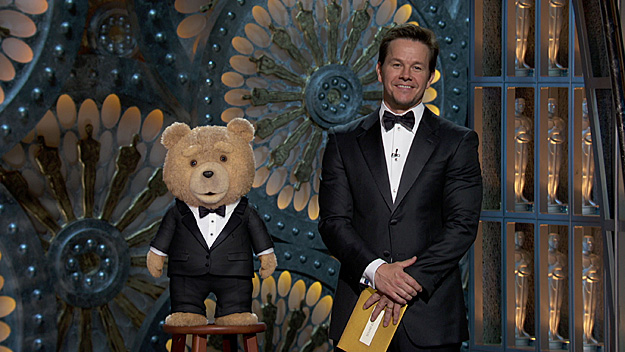Oscar Co-Presenter Animates Festivities
If you watched the Academy Awards® telecast on CBS, the most technically impressive thing you probably saw was a computer-animated teddy bear realistically interacting onstage with a live actor (Mark Wahlberg). The effect was “seamless,” as we like to say in the business, and a perfect way to present the Oscars for “Sound Mixing and Sound Editing.”
A company called Tippett Studio, in Berkley, Calif., is responsible for brining Ted, the title character from Universal Pictures' blockbuster live action/CG-animated comedy, back to life for the 85th annual Academy Awards telecast. [The studio had earlier animated a digital Ted for a Jimmy Kimmel segment last December.]

Led by Blair Clark, visual effect supervisor at Tippett Studio, a team of animators had four weeks to create all of the various motion-capture elements that went into the illusion, with cooperation from Oscar® host Seth MacFarlane (and the voice of Ted), CBS director Don Mischer and other members of the Awards broadcast team.
During pre-production of the segment, a duplicate of the Academy Awards stage was constructed at CBS Studios in Hollywood, with lighting and cameras carefully situated to perfectly match the podium set up inside the Dolby Theatre. The feat involved planning exact camera positions so that the animation (which required MacFarlane to wear a motion capture suit to “act out” the voiceover in order to make the computer-animated bear move more realistically) would integrate seamlessly on Oscar Night with Wahlberg and the show audience. Interestingly, the entire effect was rendered using off-the-shelf Dell Precision workstations. No proprietary hardware necessary.
With five nominees in each category, Tippett artists had to create 10 different outcomes, which once stored on a server could be recalled instantly during the live broadcast. This was key since the winners were unknown before the envelope was opened. Director Mischer and a dedicated TD had to be ready to push the button on the replay system to correspond with the correct winner during the live broadcast.
Clark said working with MacFarlane and Mischer “was great. Their trust and support made a technically ambitious presentation with a tight deadline run smoothly.”
Amazingly, there was a tie in the Sound Editing category (“Skyfall” and “Zero Dark Thirty” both won), which meant that the segment unexpectedly ended earlier than intended. In what must have been a panicked moment inside the NEP Broadcasting HDTV truck parked outside The Dolby Theater, Mischer cut back to a live shot of Wahlberg; without anyone at home knowing it wasn’t planned that way.
The professional video industry's #1 source for news, trends and product and tech information. Sign up below.
The effect showed how good today’s animator and visual effects specialists—with the help of broadcasters—are getting at creating lifelike characters with a computer. Incorporating 3D character animation into a pre-recorded movie or television show is one thing, but integrating an animated character into a live-broadcast in front of a global audience is quite another.
The effects for the movie “Ted” (which lost the Oscar to Disney’s “Brave”) was completed by Tippett and another studio in South Melbourne, Australia called Illoura. Here’s a video of how it was done.
